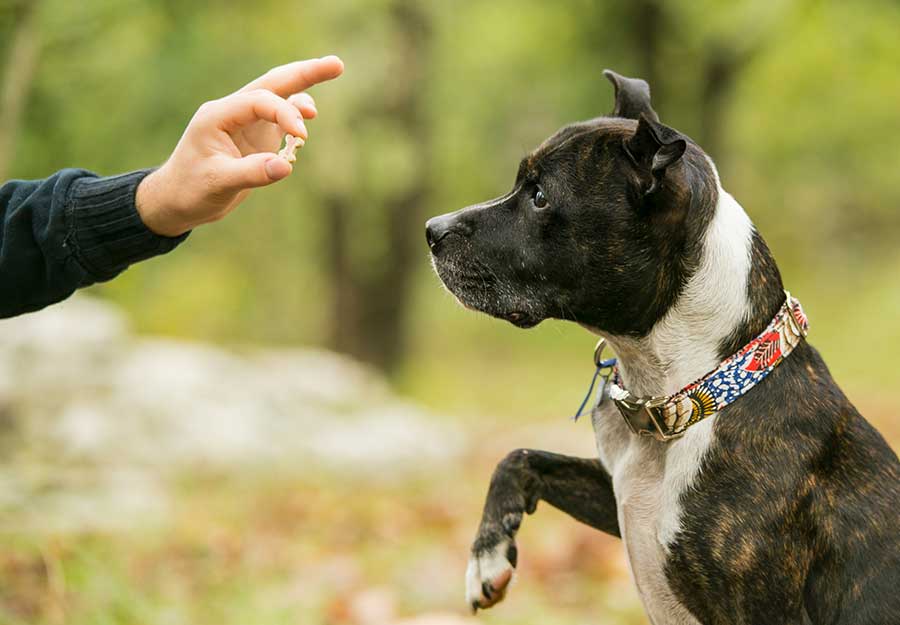
Dog Training takes time, patience, and an understanding of how your dog learns. Using the force-free dog training method reinforces positive behaviors that will build the bond between you and your dog and improve your dog’s quality of life.
An Intro to Dog Training Techniques
It’s not easy, and there is no quick fix for unwanted dog behaviour. Training your dog is a commitment that you will need to maintain for your dog’s entire life. Just like any skill, you need to practice it every day, and so does your dog.
One of the best training methods involve building a bond with your pet and pet parents. Popular force-free puppy training methods can help you and your furry best friend achieve their desired behaviour.
We connected with Certified Professional Dog Trainer, Joanna Scott from For the Love of Paws Pet Service Dog Training (FLOPPS) in Edmonton, Alberta, to talk about the benefits of Professional force-free training services.
What is Force-Free Dog Training?
One of the best methods of dog training is called force-free training. Many professional trainers practice force-free training as it is the most intuitive and easiest option for beginners, and tends to work well for most dogs. This science-based dog training can help to correct unwanted, attention-seeking, or destructive behaviours and encourage safe, productive behaviours in dogs of all ages.
Force-free training tips use humane techniques to instill positive behaviours and routines, including treat training and clicker dog training. This type of dog training doesn't use punishment-based techniques, and instead focuses on rewarding appropriate and desired behaviours.
When implementing force-free dog training techniques, you never use the following:
-
- Pinch or prong collars
- Choke collars or chains
- Manipulation of the dog's body language by forcing it to change positions
- pushing or pulling the collar or leash
- Hitting
- Kicking
- Grabbing the scruff of the neck
- Yelling
The force-free training method has been backed by the support of dog psychologists and certified animal behaviourists who understand how your dog processes different types of reinforcement.
Force Free vs Balanced Dog Training Tips
Balanced training combines reinforcement with punishment-based techniques. The technique involves giving praise or rewards for good behaviour and punishing or removing rewards to respond to bad behaviour.
This style of training can be effective, but it can also be used incorrectly, even with the best of intentions. Overly punishment-based training can lead to anxious and fearful behaviours, when the goal is to build trust and teach confidence. Consulting a professional trainer is recommended if force-free training techniques aren't effective for you.
Force-free training, on the other hand, is gentle and focuses on creating good behaviour in the canine through the use of positive reinforcement with dog treats, toys, or praise. You can even reward the dog with a fun activity that they enjoy, such as going for a walk after a job well done.
The training style you choose should be based on how comfortable you are using the method, what types of behaviours you are trying to train, and your dog's current behaviours. For the average pet owner, and especially for those who are new to dog training, we recommend force-free techniques.
The Best Way to Train Your Dog: Positive Reinforcement
The preferred way to train your dog is to use positive reinforcement. The concept focuses on giving the canine something they want or desire, such as a favourite toy or treat, which acts as a driver to ensure that the pup continues to repeat the task or behaviour to gain the reward.
When learning how to train a dog, force-free training provides the best results when dealing with an uncertain or fearful canine, as this gentle technique will not escalate those emotions further and can help build their confidence over time.
If your pet starts to behave inappropriately, then you’ll want to try to understand the dog’s emotions and then implement respondent conditioning play sessions, which is a protocol that focuses on changing your dog’s emotional balance from negative to positive, so your pup starts to feel calm, happy and more focused.
When learning about force-free dog training tips, you’ll discover that the technique is science-based and effective because you form a solid bond with your dog. You’ll need to remain patient, stay persistent, and be committed to success.
Operant Conditioning
When we talk about reinforcement, we refer to the concept of operant conditioning. It is a method of teaching new behaviours through the use of either reward or punishment-based techniques. There are four quadrants of operant conditioning:
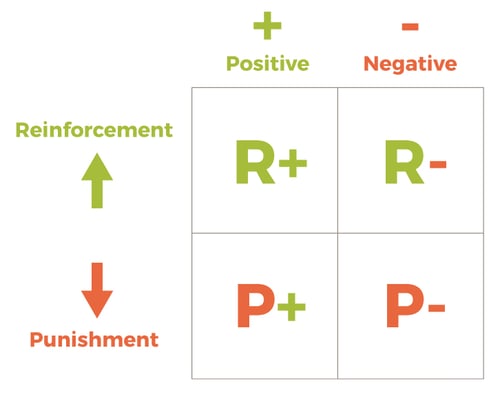
1. Positive Reinforcement | R+
Adding a desired stimulus or reward. Treat training is a form of R+. You ask your dog to sit, and if he does, you would reward him with a treat or praise.
2. Positive Punishment | P+
Adding a punishment. This means punishing your dog for unwanted behaviour, like the use of pinch collars, shock collars, or other corrective tools.
3. Negative Reinforcement | R-
Removing a harmful or unwanted motivation or punishment. This is paired with positive punishment, like the use of a shock collar or choke chain. The P+ is pain or punishment from the collar, and the R- is the release of that punishment when the unwanted action stops.
4. Negative Punishment | P-
Taking away or denying an expected reward. Ignoring your dog's bad behaviour when you enter your home is a good example. P- will teach the dog that jumping, barking, or other signs of over-excited behaviour will not be rewarded with attention.
You may have noticed that the words positive and negative in the chart do not refer to good or bad; instead, they refer to the act of adding or removing.
Force-Free Dog Training at Home
Can you guess which one of these is considered force-free training?
If you guessed positive reinforcement techniques or R+, then you’re right! Positive reinforcement is the core concept of force-free dog training services. When using positive reinforcement techniques, your dog will learn to connect a positive action with a reward or praise.
Negative punishment, or removing an expected reward, can also apply to force-free training. This is the process of correcting or discouraging unwanted behaviour in a force-free manner.
An example would be when your dog jumps at you to get your attention. Force-free correcting would involve you turning your back on your dog and ignoring him. This tells him that his behaviour will not get him the attention or reward that he is looking for.
How Can Force Free Dog Training Help You?
Applying this training style at home is easier than you think. You may already be using force-free dog training methods and hand signals, and you just don’t know it.
Simple tasks like treat training are a great way to teach your dog good behaviour. Start small and work up to more challenging behaviours. Force-free dog training can be used to help correct some of the most common behavioural concerns in dogs, like:
The possibilities are endless. With the right techniques, you can teach your dog good doggy behaviours and some cool party tricks.
Basic Force Free Dog Training Examples
Dogs will need to learn a wide variety of tricks, behaviours and skills over their lifetime, but there are some basic behaviours that most dog parents will need to know how. Here are some simple lessons you can start with to help you build a trusting bond with your dog:
1. Basic Treat Training
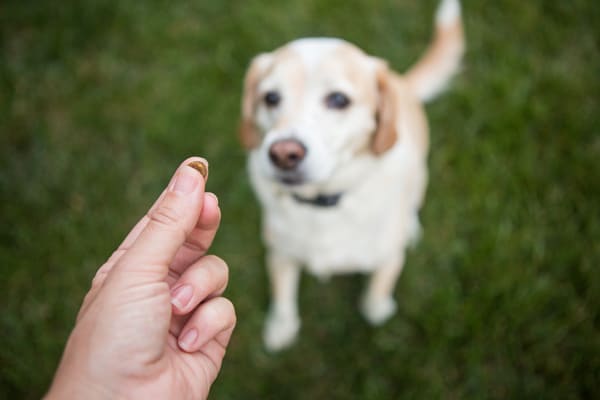
This is the foundation of most crate training. Simple one-word commands can be used in many situations and can help to keep your dog safe and attentive to your commands.
Start with easy commands like sit, stay, or paw. Reward quickly for each successful attempt. Once your dog is confident in demonstrating these basic commands, you can start to apply them to new situations.
For example, using the like-sit command when guests come over will be challenging for excited dogs, but it will help to keep them calm and prevent behaviours like jumping. In time, that behaviour will become second nature, and your dog may start new interactions with this action.
Make sure that you continue to praise this behaviour well after it is learned. A simple good dog or a pat on the head will let them know that they are doing the right thing.
To make dog treat training fun, you have to have fun treats. Find your dog's favourite in The Best Training Treats for Dogs.
2. Good Walking Behaviour

Walking your dog beside or at least very close to you will give you more control over your dog's safety. This is called loose-leash walking.
Whether you are at a dog park, on a walk, or in a pet store, you can keep your dog safer if they are close to you and paying attention to your movements.
Directing them by not letting them lead is a great way to teach this. Force-free training tips for loose-leash walking use both hand signals, positive reinforcement and negative punishment.
When your dog pulls, stop and casually walk in a different direction. By taking away their control over the direction of the walk (P-) and then reinforcing and rewarding them when they turn to follow you (R+), you are telling your dog that following your movements and directions is correct.
3. Homecoming
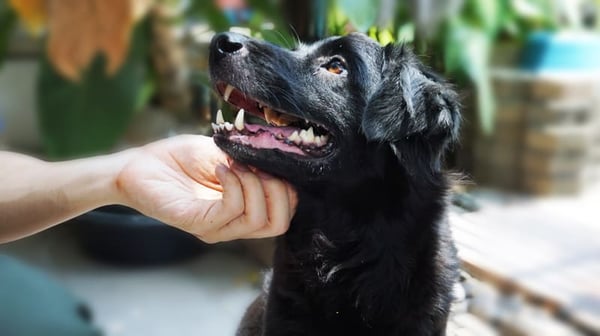
It’s very common for dogs to be excited when you come home. Teaching them to stay calm until you are ready to give attention can be tricky, but with some repetition, not impossible.
Using the P- technique, ignore your dog. He may jump, bark, roll or do anything to get your attention. Don’t look at him, speak to him, or pet him.
Once he calms himself, sits, or otherwise stops the unwanted behaviour, then you can reward him. For some dogs, this can be a few minutes, for others, it could be much longer, so be prepared to outlast your stubborn dog. By not reacting to them and only rewarding the good behaviours, your dog will learn that calm, quiet behaviour is correct.
Do You Need a Professional Trainer?
No one said that training your dog would be easy. The fact is, some dogs require more training than others. Whether you are handling a new puppy, a fearful rescue, or an easily excitable dog, working with a professional trainer will get you there more efficiently by teaching you the skills and techniques that your dog will respond to.
When asked about what to look for in a trainer, Joanna recommends doing some research about the trainer and the classes they offer.
“If you are looking to hire a dog trainer, it’s important to make an informed decision to keep your dog safe and make sure they’ll be treated humanely. To do this, look for a Certified Professional Dog Trainer.”
Look for a trainer with these letters behind their name to tell you if they have the proper certification:
-
- CPDT-KA (Certified Professional Dog Trainer - Knowledge Assessed)
- CBCC-KA (Certified Behaviour Consultant Canine - Knowledge Assessed)
- IAABC (International Association of Animal Behaviour Consultants)
What is a Certified Professional Dog Trainer (CPDT)?
This refers to an experienced professional dog trainer who must stick to the highest codes of conduct and must be committed to only giving the highest levels of teaching your dog and dog training education.
To obtain this certification, trainers must complete hundreds of hours of training under the supervision of a Certified Professional Dog Trainer, as well as take an intensive exam to test their knowledge.
Here are some helpful resources to find a certified trainer near you:
Don’t be afraid to ask questions about the type of classes available. Finding the course and trainer that best suits your dog will ensure a more successful training experience and training class.
You may have options for group classes, one-on-one, at-home visits, and even virtual appointments to make sure that you and your dog are set up for success.
Force Free Dog Training Tools for Success
Once you find a trainer and a class that suits your dog, make sure that you ask about what you need to bring or do to prepare for your puppy training classes. There are some important tools that you should bring to every class. Your trainer may also recommend specific equipment to help you and your dog learn.
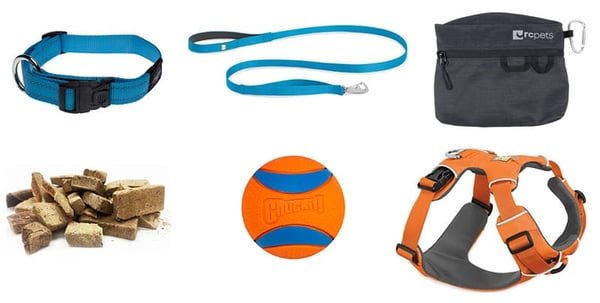
These items are on the “must-have” list for the team at FLOPPS:
A Flat Collar
Not a martingale, slip lead or choke chain. A flat, well-fitting nylon collar. Avoid anything that tightens or pinches. This type of reinforcement training technique is not compatible with force-free training.
A 6-Foot Leash
Not a retractable lead, just standard 6ft nylon. This gives you more control and keeps your dog safer, not to mention close enough to easily get their attention.
Treats
Make sure they are treats that your dog loves. Opt for small training treats or soft and chewy treats that you can cut into tiny pieces. This will prevent overfeeding them during the house training classes.
A Toy
If your dog is not very food-motivated, then bring your dog's favourite dog toy that will hold your dog’s attention. If you are in a group setting, avoid toys that will be disruptive to other dogs. A ball or a stuffed toy will do the trick. Even if your dog is not a foodie, a toy is a nice change of pace when your dog starts to lose focus in the living room.
A Treat Pouch
A Ziploc bag in your pocket will work, but a clip-on treat pouch is the best for quick and timely rewarding. You will be doing a lot of rewards, so come fully stocked. Extra picky dogs may need something out of the ordinary, like hot dogs or cheese, to keep them attentive.
A Harness
Harnesses are a good idea if your dog tends to choke themselves by pulling. If you are not familiar with dog harnesses, ask your new trainer what style they would recommend for your dog. Check out Best Dog Harnesses for more info. Harnesses aren't ideal for all types of training classes, but are a great tool for at-home dog training.
A Positive Attitude
Go into puppy training classes and clicker training with the mindset of success. Your dog will feel your stress, anxiety, and frustrations. Don’t let yourself get bogged down if your dog requires more time or attention. Every dog is a different type, and your trainer will ensure that your dog gets the most out of their classes.
Are You Ready to Make a Change?

There is no shame in needing help. That’s what professional dog trainers are for. They share their extensive knowledge and experience to make a difference in your dog’s life. No judgment for you or your dog.
Training should be a fun and enjoyable experience with baby gates for both you and your dog. It will strengthen your bond with your pet, build trust, and help you build a safe and healthy routine in your home.
Whether you are a new pet owner or just trying to teach an old dog new tricks, investing in professional dog training services will help you reach your goals.
Ask the Expert: Frequently Asked Questions
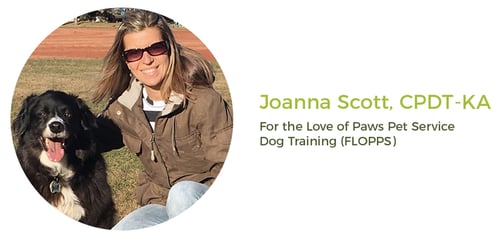
To further help you succeed in your training goals, we asked Joanna about the dos and don’ts of working with a professional dog trainer:
1. What can dog owners do to prepare for their first class?
All vaccination records should be reviewed before class to ensure the health and safety of all dogs in the class.
2. What are some positive routines that pet owners should incorporate at home to help maintain lessons from class?
Look for and reward positive behaviours in your dog while correcting and praising them for potty training. Implement the Learn to Earn Rule by asking your dog to perform tasks in exchange for what they desire, like sitting before meals or greeting guests, fostering polite behaviour and strengthening the bond at home.
3. What are some of the top mistakes that pet owners make that are more harmful than helpful when it comes to their training?
Punishing a dog verbally or physically not only damages the bond between a dog and its owner, but it also causes the dog to avoid doing those behaviours in front of the owner. It doesn’t teach the correct behaviour, and without teaching correct behaviour, your dog will continue to make mistakes.
4. What should a dog owner expect from your services?
FLOPPS provides effective, lasting dog training using force-free techniques by a certified trainer experienced in various cases. Smaller class sizes ensure more individualized attention, and we also offer one-on-one sessions, including in-home training.
5. Can force-free training be applied at home, or should I seek professional guidance?
Force-free training techniques can be used at home, especially for basic obedience training. However, for more complex issues or specialized training, consulting with a professional force-free trainer is often beneficial.
6. Are there any challenges or limitations to force-free dog training techniques?
Force-free training may require more time and patience compared to punitive methods. It also relies on finding the right motivators for each individual dog.
.png?width=200&height=66&name=logo%20(1).png)

%20(1)%20(1)%20(1)%20(1).jpg?width=221&height=221&name=flopps-logo%20(1)%20(1)%20(1)%20(1)%20(1).jpg)
.jpg)
